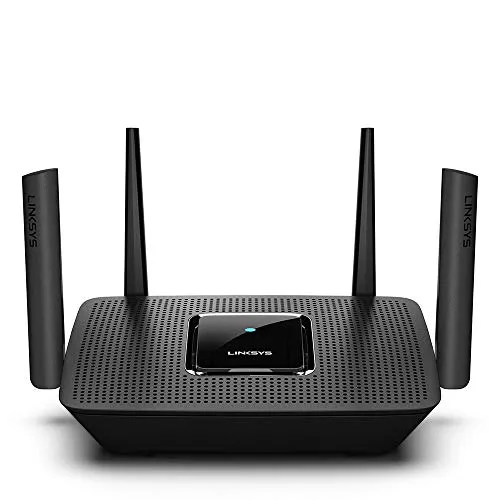Linksys MR8300 AC2200 Mesh Router Review
As an Amazon Associate, we earn from qualifying purchases at no cost to you.
Linksys’ Velop line of mesh routers have been a popular choice for people struggling with WiFi dead zones in their homes. The MR8300 gives you the look of a traditional router with the benefit of working with the Velop mesh system.
Who should buy this router?
First off, you don’t want to use this router by itself. To fully take advantage of this router, you’ll need at least one of the Velop nodes. This allows you to the expand the WiFi coverage as needed.
You can think of a mesh system as placing multiple routers around your home to blanket it in WiFi coverage. While the best place for your router is a central location in your home, who actually places their router there? Usually, you need to connect your router near a cable or phone line jack, which is typically located on an exterior wall of your home, which limits the coverage in your home since half of your WiFi signal is going outside.
Setup
The setup process is very easy as you only need your smartphone and the Linksys app. Thanks to Bluetooth technology built into the Velop system, the app automatically detects the router and your internet connection, and then configures it with the network name and password that you want. This sure beats the setup of traditional WiFi routers, which usually involved connecting to a temporary WiFi network, configuring it, then disconnecting and reconnecting to the new WiFi network. And it’s definitely better than installing a program from a CD-ROM disc (anyone remember that?!).
If you have an existing router in your home (perhaps your internet provider gave you a combo modem-and-router-in-one), the MR8300 can be placed into “bridge mode” which allows you to use your existing router with the range-extending antennas of the MR8300 and any associated Velop nodes.
Performance
The MR8300 broadcast 3 bands:
-
a 2.4Ghz band that most WiFi devices use,
-
a 5Ghz band that newer smartphones and streaming boxes use
-
an additional 5Ghz band dedicated to connecting the mesh system together
Typically, if your device supports 5Ghz, you’ll want to use that because it’s faster. However, the 5Ghz band doesn’t go through walls or travel as far as the 2.4Ghz band does, so having a mesh system that gives you multiple 5Ghz spots throughout your home can improve WiFi performance.
My internet service maxes out at 100 Mbps and I was happy to find that I was able to hit that speed in the far corner of my home where it would previously only reach about 30-40 Mbps with my old router. I only needed one additional Velop node to get coverage throughout my 4-bedroom home.

I’m now able to hit my max speed (100 Mbps) in the far corners of my house.
With the Linksys app, you are able to monitor which of your devices are connecting to which node. Although I have a node setup in my home office with my Mac Mini, I’ve found that my Mac Mini will skip over it from time to time and connect to the MR8300 router on the opposite end of the house. I’ve noticed my other devices occasionally doing the same thing: connecting to the node located furthest away from them. It baffles me, but all my devices seem to be performing fine regardless.
Features
Oddly, the USB 3.0 port on the back of the router is currently non-functional and is reserved for “future expansion”. I imagine it will function like the USB ports on other Linksys routers and will allow you to plug in a USB flash drive and hard drive for use as network storage, but at this time (February 2019), it doesn’t do anything.
Power users will appreciate features such as port-forwarding and MAC address filters, which can be administered through the Linksys app. More features are also available on the web interface to the router, but oddly some things can only be done in the app (such as setting up and viewing nodes) while others can only be done in the web interface (such as creating separate names for the 2.4 and 5Ghz networks).
Our Verdict
With about 40 devices on my network, the MR8300 has performed very well and has definitely improved areas of my home where the WiFi was lacking with my last router. One of the major benefits of the Velop system is that you can expand it as you go by adding nodes individually to your mesh network. The MR8300 is a great starting point, but remember that it will work best if you purchase a Velop node to go along with it.
PROs
- Works with the Linksys Velop system
- 4 Ethernet ports
- Fast processor
CONs
- Full benefits are only realized when connected with at least one other Velop node
- USB port is non-functional as of February 2019





 Hi, I'm Ryan! I've worked in the IT industry for over two decades and I love checking
out new gadgets, apps, and services that make our lives easier.
Hi, I'm Ryan! I've worked in the IT industry for over two decades and I love checking
out new gadgets, apps, and services that make our lives easier.